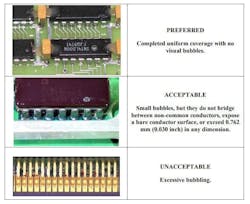Banish Moisture to Boost EV Reliability
What you’ll learn:
- Applicable standards for describing and achieving moisture protection.
- The role of enclosures and sealants in providing moisture protection.
- How potting, conformal coatings, and various other techniques can complete the moisture control picture.
- What are some other means of protecting circuits from moisture?
The incompatibility of water and electrical systems is a fundamental principle of electric-vehicle (EV) design. However, achieving reliable moisture exclusion is non-trivial. For example, sealing alone doesn’t necessarily preclude condensation due to initial humidity or long-term ingress through nominally sealed interfaces. Therefore, mitigation strategies must extend beyond simple sealing, especially for devices exposed to mechanical stress, such as those installed in electric vehicles.
The determination of the most appropriate water intrusion and condensation protection approach hinges on a risk-based assessment, considering both the cost of the device and the potential consequences of its failure. For example, given its operational criticality, the traction inverter necessitates the highest level of protection.
The DC-DC converter, responsible for the 12-V battery, presents a lower risk profile, as temporary operational continuity is feasible with a failing system. The onboard charger, increasingly targeted for improvement as investments in charging infrastructure lag, is also not of much concern during vehicle operations. At worst, it risks inconvenience when encountering remote charging failures, though its costs must weigh in as a factor as well.
Applicable Standards for Describing and Achieving Moisture Protection
Some standards can provide guidance in developing moisture-resistant designs. NEMA and IEC 60529 (IP) are the primary enclosure sealing rating systems. They overlap somewhat, but they’re built on slightly differing philosophies.
NEMA uses a number (physical/water resistance) and optional letters (e.g., corrosion, ice) to summarize details. IEC uses a two-digit IP rating (physical, then water resistance). Higher numbers generally indicate better protection in both systems, but exceptions exist.
For example, NEMA 5 is dust-resistant, not water-resistant, while NEMA 6 is immersion-proof. NEMA 4 and 4X enclosures provide a level of water resistance for out-of-doors applications such as docks, dairies, and wastewater facilities. Similarly, IP67 withstands immersion but not necessarily water jets, and IPx8 allows for some water ingress at depth. Both systems can be counterintuitive.
>>Download the PDF of this article
Environmental hazards like vibration, shock, and explosive gases are critical for onboard devices (inverters, DC-DC converters), though less so for stationary chargers. Ignore these risks at your peril. Temperature swings, especially during cool down, can induce condensation—a silent killer of high-power electronics. Even with near-perfect efficiency, a 100-kW device still generates 1 kW of destructive heat.
How Can Sealants Play a Role in Controlling Moisture?
Effective enclosure sealing mandates the use of compliant materials—rubber gaskets, silicone caulk, and the like—to bridge gaps, seams, and penetrations. These materials are essential for accommodating differential thermal expansion between dissimilar components.
Cable penetrations present a unique challenge. While gland nuts provide robust water resistance, they may fail to prevent air ingress—a critical oversight given that air carries damaging water vapor. Robust, comprehensive sealing is therefore a design element to prioritize.
The curing process of sealants generally involves the release of volatile organic compounds. Certain general-purpose silicone sealants can emit byproducts such as methanol and ammonia, or acetic acid. These off-gases can have detrimental effects on surrounding materials, especially electronic components.
In addition, methanol may interact negatively with some plastics, while ammonia can cause discoloration on copper surfaces. Acetic acid is known to promote corrosion on certain metals. To mitigate these risks in sensitive applications, particularly in electronics, specialized "electronics-grade" silicones have been developed. These formulations are designed to minimize or eliminate the release of corrosive and reactive byproducts during their curing phase.
How Can “Potting” and Conformal Coatings Protect Against Moisture?
Protective internal coatings are another common strategy for contaminant mitigation. These methods include conformal coating, a selective application to printed circuit boards and exposed conductors via spraying or dipping; and potting, the complete filling of an enclosure's internal volume (see figure). A range of coating and potting compounds exists, each with specific performance characteristics.
Certain materials, such as silicones and epoxies, are versatile and suitable for both conformal coating and potting. Other materials are usually reserved for more specialized applications: acrylics and polyurethanes are primarily used for conformal coating, while asphalt is exclusively employed for potting. As with sealing, careful consideration of the material's properties is essential for optimal performance.
Selecting a coating or potting material demands careful consideration of compliance for thermal expansion, mirroring enclosure sealing. However, unlike simple sealing, electrical factors add complexity: high voltage differentials and rapid voltage changes necessitate materials with robust dielectric properties. Furthermore, application timing differs—coatings and potting occur late in assembly, impacting repairability.
Acrylic coatings offer easy removal, contrasting with silicone's mechanical-only removal and epoxy/polyurethane's near-permanent application. While enclosure sealing with acrylic conformal coating often suffices, high dielectric needs favor targeted silicone application. Potting, a last resort, primarily suits cost-driven, non-repairable devices. All of this work can, in some cases, be supplemented in component selection. For example, components such as capacitors, can also be specified for high water resistance.
What are Some Other Means of Protecting Circuits from Moisture?
Yes, a few more “tricks” are still available to fight moisture, namely desiccants, molecular sieves, or “active” measures such as heating.
The well-known desiccant, silica gel, while economically advantageous, has only limited performance, particularly regarding the minimum achievable relative humidity. Under typical operating conditions, a lower bound of approximately 40% relative humidity is observed, with diminished effectiveness at ambient temperatures exceeding 35°C.
Molecular sieves, utilizing zeolite's precise pore structure, can provide good performance, achieving significantly lower humidity levels even under demanding thermal conditions. Though molecular sieves may exhibit increased friability, this is a manageable engineering challenge, outweighed by their performance advantages.
Both silica gel and molecular sieves offer regeneration capabilities and humidity indicators, ensuring proactive maintenance. However, for applications demanding uncompromising humidity control, molecular sieves are usually the better option.
Active humidity control methods offer a viable alternative in environments where external air ingress is anticipated, such as during cooling or maintenance procedures. One technique involves elevating the internal cabinet air temperature above the dew point. This can be achieved through continuous heating, utilizing a PTC element for inherent temperature regulation, or by employing a controlled heating system.
Control mechanisms may include thermostats, humidistats, or combined systems to optimize energy consumption. However, the integration of active humidity control within EV power electronics presents significant challenges, primarily due to space constraints and the associated increase in battery power consumption.
While none of these options are perfect, the wide range of technologies offers the ability to tailor something that’s close to ideal for a given situation.
References
“Workmanship Standard for Polymeric Application on Electronic Assemblies”
>>Download the PDF of this article
About the Author



